Last week’s Tour de France route reveal has really whet the appetite for Grand Tour season next year. And with so many great stages just over the Channel, why not make a plan to go and tick one (or all) of them off yourself?
Let’s face it: riding in France is great, and realistically you could pick any one of the 21 stages (okay, two and a half of them are in Spain) and ride it, and have a super time. But like in the real race, some of the stages are more appealing than others.
I’ve picked out some that tick the boxes for me, but everyone’s different, of course. Which stage would be the one you’d most like to ride yourself? Let us know in the comments below.
 Alpe d’Huez (credit: road.cc)
Alpe d’Huez (credit: road.cc)
1. The big one
Stage 20 Le Bourg d’Oisans > Alpe d’Huez (171km)
No two ways about it: at 171km, and with 5,600m of climbing, the Queen Stage of the 2026 Tour is going to be a big day out on the bike.
If you’re looking to tick off the icons of the Tour de France, this Tour packs in the Croix de Fer, the Telegraphe/Galibier double header and an Alpe d’Huez stage finish… it doesn’t really get any more iconic than this. Maybe the race will be sewn up by stage 20, but there’s huge potential for a major shake-up in the GC on a parcours as hard as this. I can’t remember seeing a harder one!
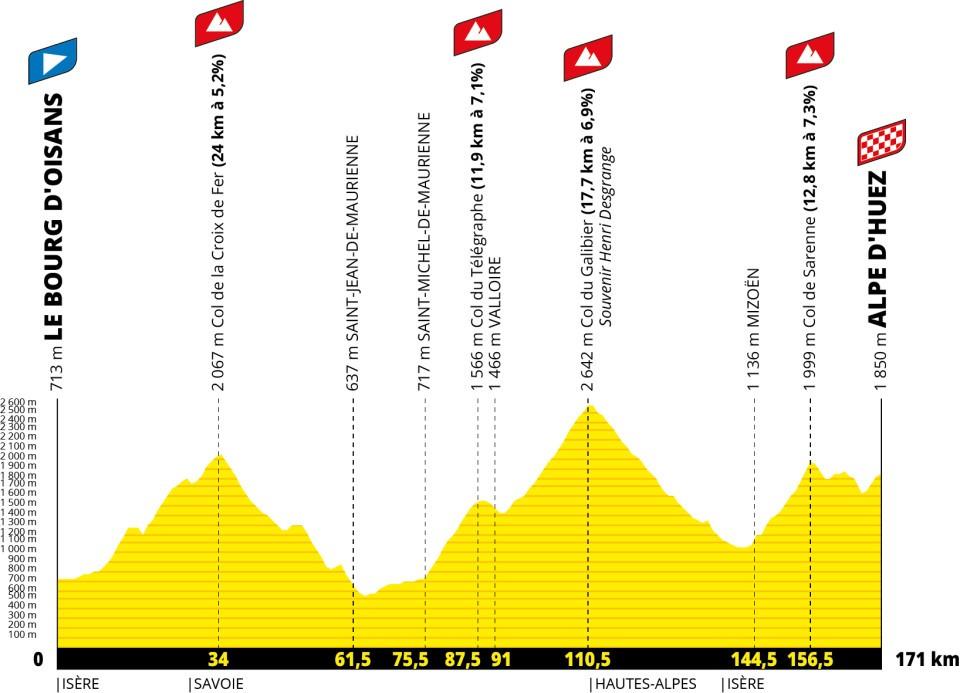 Tour de France 2026 stage 20 (credit: letour.fr)
Tour de France 2026 stage 20 (credit: letour.fr)
From a logistics perspective this is an ideal stage, because it’s a loop: Bourg d’Oisans is right at the foot of the 21 switchbacks of Alpe d’Huez, so once you’re done (and you WILL be done) you can roll back down for a well-deserved beer.
The Goodwin brewery just down the road is run by an Englishman, who does a sort or mash-up range of British-style beers with a French twist. Alternatively, you could just miss out the final climb: the Croix de Fer and Galibier in one day will be enough for most (it definitely would be for me) and if you’re staying in the area then you could just tackle Alpe d’Huez another day on fresher legs.
This stage doesn’t actually go up the famous hairpins, by the way. It loops round the back, going up the Col de Sarenne which has never been used as a climb in the Tour before, although it has been a descent. Up until a few years ago it wasn’t much more than an access road, and it has a very different vibe to the busy and wide main climb, with great views back across the valley.
Getting there
Bourg d’Oisans is about nine hours by car from Calais, so it’s certainly not out of the question to drive, especially if you have a friend to share the driving with.
If you’re going to fly, then Chambéry is the closest, but flights from the UK are scarce. Lyon isn’t much further away in terms of time though, and Geneva and Turin are also options.
If you want to take the train, then the TGV will get you directly to Grenoble from Paris Gare de Lyon.
Other places to ride in the area
Where to begin? There are so many famous Tour climbs right out of the door, or within reach with a short hop in the car. You could spend a fortnight on your bucket list round here. If you have the legs!
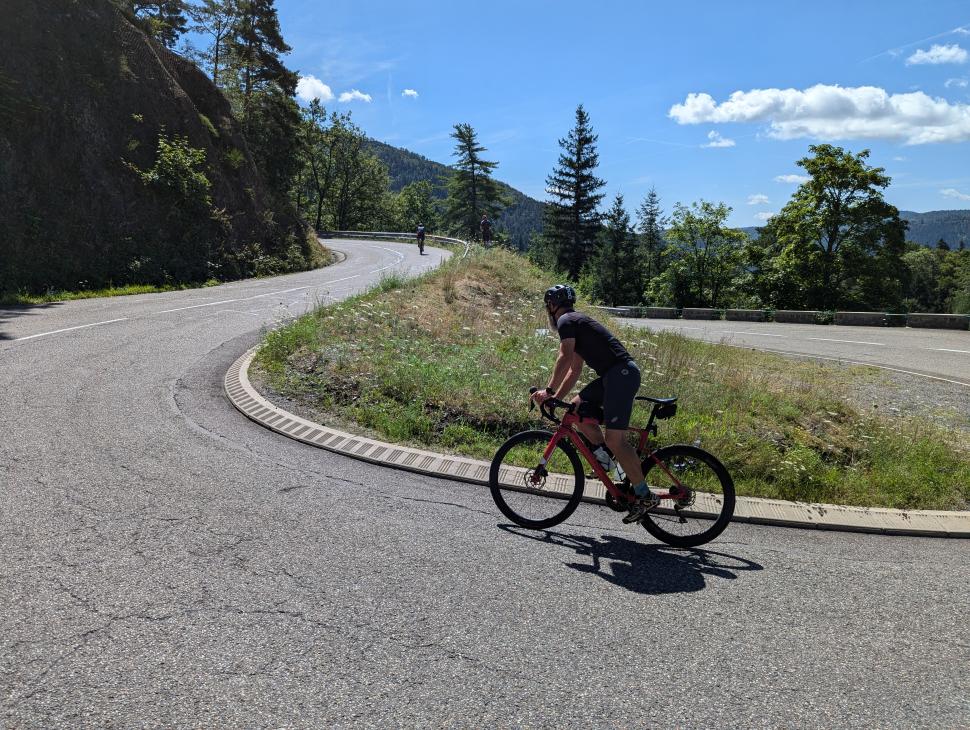 Climbing in the Vosges mountains (credit: road.cc)
Climbing in the Vosges mountains (credit: road.cc)
2. The hidden gem
Stage 14: Mulhouse > Le Markstein Fellering (155km)
Tucked up in the top right-hand corner of France, the Vosges is a hugely underrated destination for UK cyclists, and it’s much nearer than the Alps or the Pyrenees, and easily driveable from Calais on fast roads.
It has some iconic Tour de France climbs, including the brutal altiport finish at La Planche des Belle Filles, and a huge network of great riding that criss-crosses the spine of the hills that run north to south.
Because it’s reasonably far North (a similar latitude to Brittany) the weather isn’t quite as locked in as it is down south, but the benefit for pasty UK cyclists is that the summer temperatures are more bearable too.
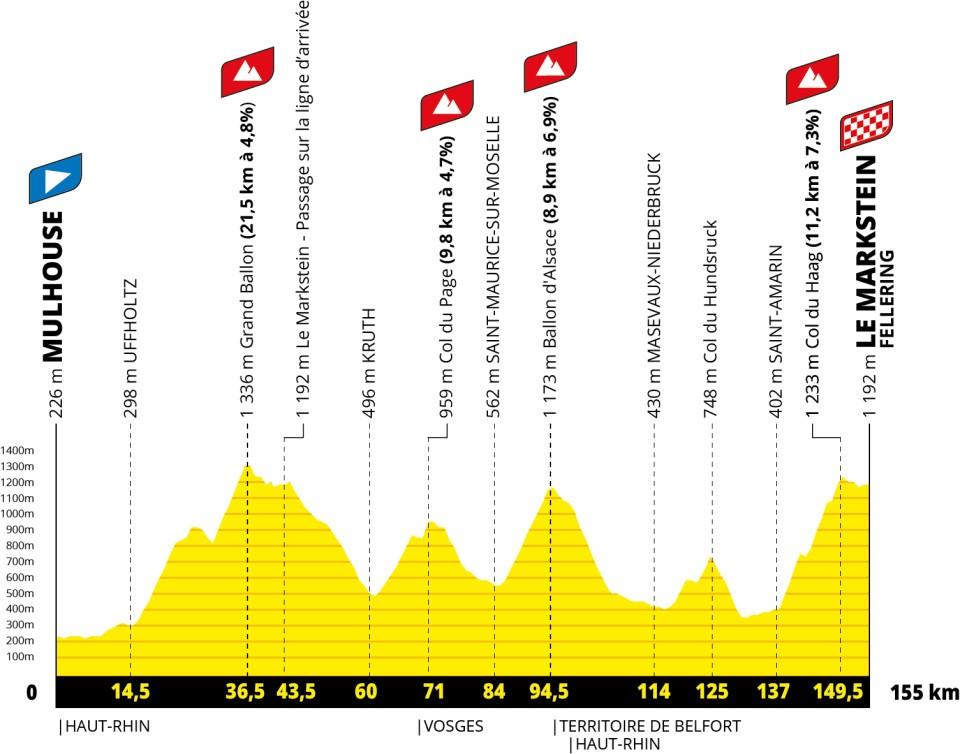 Tour de France 2026 stage 13 (credit: letour.fr)
Tour de France 2026 stage 13 (credit: letour.fr)
Again, this one is almost a loop. After the initial climb of the Grand Ballon from Mulhouse, you drop to the ski resort of Le Markstein and go through the start/finish line about 45km into the stage.
One option is to start there, and just do the loop after. You’re missing out on the first big climb, but it’s still a 105km day out with plenty of hard work. Or you could start at the bottom of the first climb (in Thann or Cernay) and then make a call on the final climb of the day when you get to Saint Amarin.
It looks like that final climb is on the traffic-free route to Col du Haag that’s a repurposed road, and a great way to climb the mountain, so it’d be a shame to miss out. If you’re stopping at Le Markstein, have a go on the mountain coaster!
Getting there
One of the great things about the Vosges is it’s pretty driveable. Roll off a ferry or out of the Channel terminal, and you’re about six easy hours from Gérardmer. Mulhouse isn’t much further in terms of distance, but you’re on the other side of the mountains, so it’s an extra hour.
If you’re going to fly then Basel is the obvious choice. There’s a TGV direct to Mulhouse from Paris Gare de Lyon too.
Other riding in the area
Tick off the La Planche summit finish (do the extra gravel of the Super-Planche if you’re still feeling fresh at the cafe), and head up the nearly traffic-free Ballon de Servance at the end of the valley. There’s beautiful flatter riding in the Thousand Lakes region just to the west of the mountains.
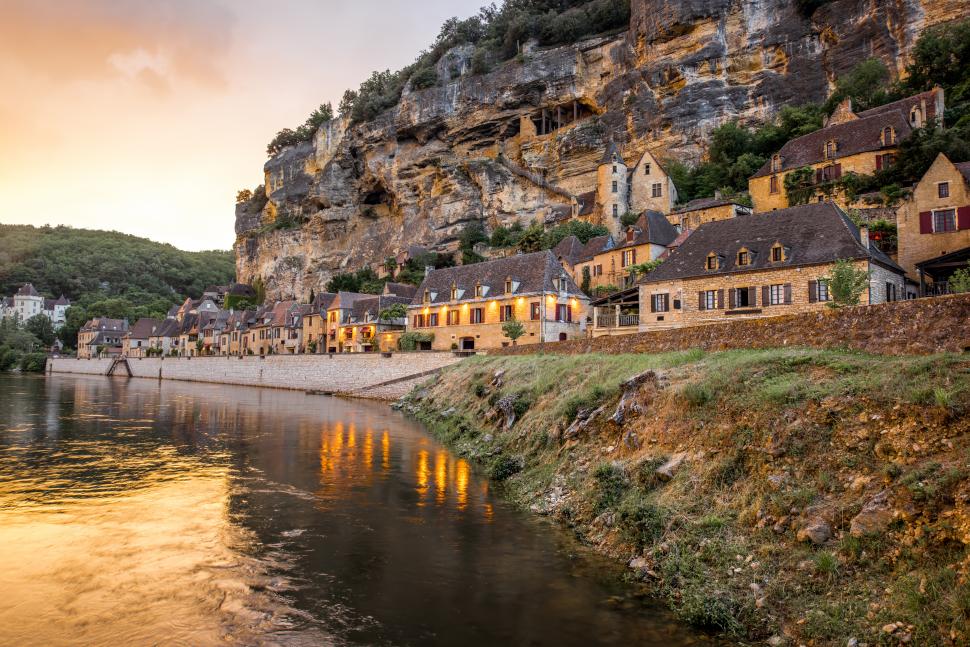 la-roque-gageac-village-in-france-2025-03-14-20-45-11-utc (credit: envato)
la-roque-gageac-village-in-france-2025-03-14-20-45-11-utc (credit: envato)
3. The easy life
Stage 8: Périgueux > Bergerac (182km)
If you’re looking to base yourself in France for a bit of Tour watching as well as Tour riding, then stage 8 is a great bet. You might even get to see the race four times! It’s also a stage that lends itself to being split up into a more leisurely tour, if that’s more your thing.
Four times? Yes, if you time it right. Get yourself to Bordeaux and watch the frantic finale to stage 7, then hotfoot it over to Perigieux for the start of stage 8. The finish in Bergerac is only just over 50km away, so even at a leisurely pace you can get there on a bike before the sprinters do: you’ve got just under four hours. Then ride back (or get picked up if you have a non-riding friend or partner to drag along) and make your way to Brive-le-Gaillard for the start of stage 9. Lots of action for not much effort!
If that sounds like too much rushing around, how about taking in the route of stage eight over a few days? There’s loads to see on the route, although we’d probably advocate for playing a bit fast and loose with the specifics: flat Tour de France stages tend to be on wider, faster roads, and those can be busy when the Tour’s not in town.
Fortunately this area is packed with pretty and quiet lanes, and masses of history. The Vesunna Museum in Perigieux houses the well-preserved ruins of a Gallo-Roman town house, and is well worth a look before you leave town.
Heading east you’ll also be heading back in time, to Montignac and the world-famous Lascaux caves and their prehistoric wall paintings. The original caves have been closed to the public for more than 50 years, but the latest replica cave on the site, Lascaux IV, is a perfect reproduction. From there the route heads south through Sarlat and past the imposing Fort de La Roque-Gageac built into the cliffs above the Dordogne river.
After this, you’re in the heart of wine country. There are ample places to stop and sample the local reds, and you could drop a bit further south to Monbazillac if you prefer something a bit sweeter. Take two or three days to complete the loop and really enjoy yourself.
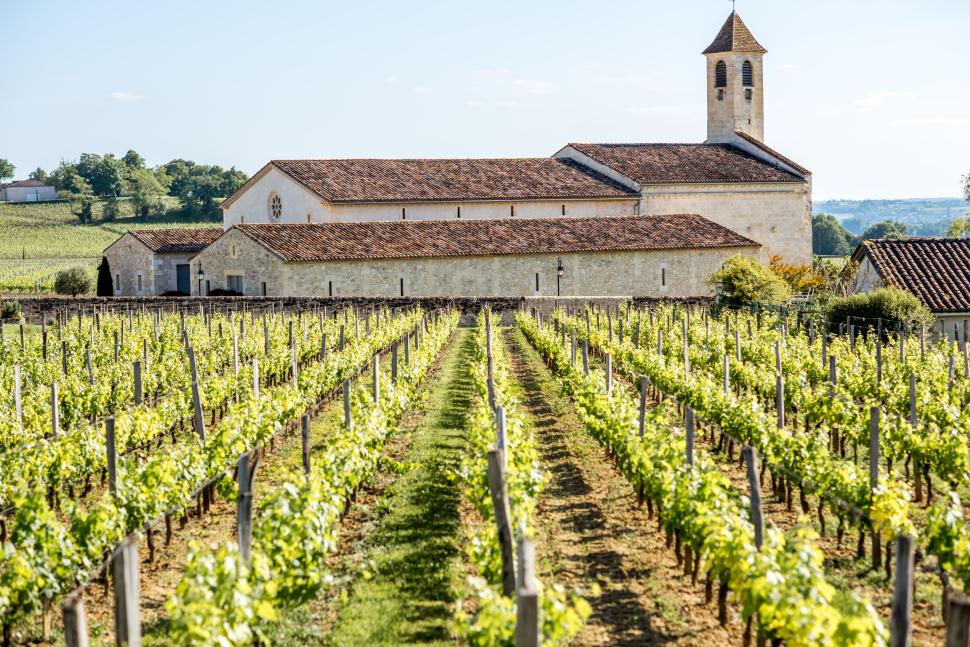 Saint Emilion vineyards (credit: envato)
Saint Emilion vineyards (credit: envato)
Getting there
If you take a ferry to Caen or St Malo it’s not much more than five hours to Bordeaux, and an hour from there to Perigieux. Bordeaux is also the best bet for a direct flight from the UK, although Bergerac is also served in the summer.
The TGV also runs direct to Bordeaux out of Gare Montparnasse, and there are local services inland from there.
Other riding in the area
If you’re driving and you have room for two bikes, stick the gravel iron in the boot as well, because there are loads of great trails around the coast.
Head out towards the Dune du Pilat, the tallest sand dune in Europe. There are loads of quiet lanes (and opportunities to drink wine) in the Médoc too, North of Bordeaux and out on the peninsula.
4. Making a week of it
Stage 3: Granollers > Les Angles 196km
With the 2026 tour starting in Barcelona, there’s the opportunity to ride a stage that takes in two countries.
Stage 3 heads into the Pyrenees from the Spanish side, before finishing up at the ski station of Les Angles on the French side. On the way over the border you’ll pass the enclave of Llívia, which is still Spanish on account of some top-drawer pedantry from King Félipe when the border was being rationalised back in the 1650s. Watch this vid for how that transpired…
This is classified as a mountain stage, but there will be more brutal challenges to come. The climb up to the Spanish border is pretty gentle by Tour de France standards, and the drag up to Font Romeu even more so.
This early on in the race, the focus will be getting everyone over the line (and maybe giving the yellow jersey to a new team for a bit), so the route is on some pretty big roads up through Vic and Planoles.
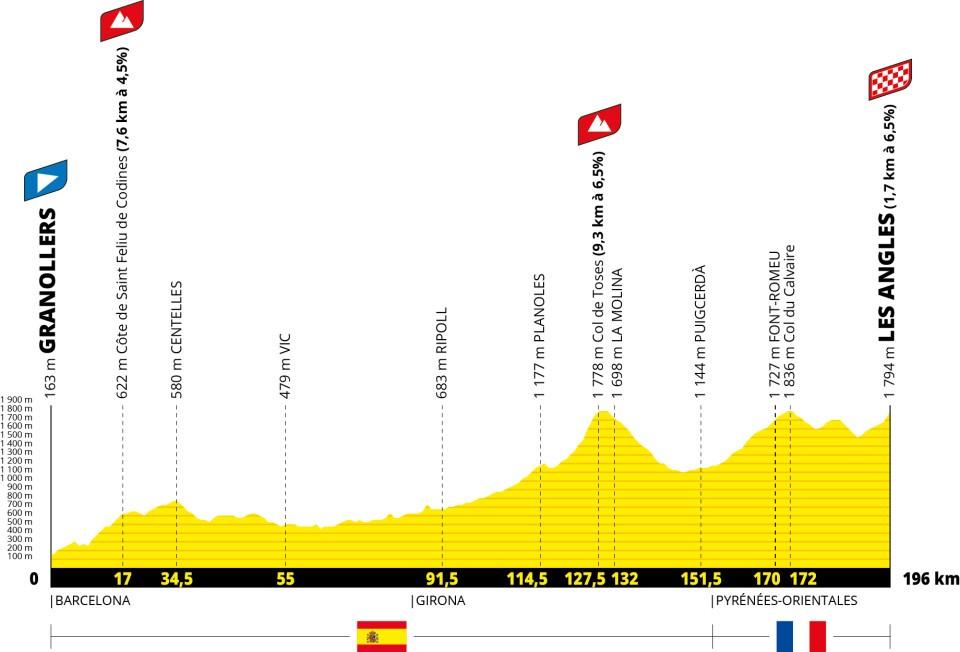 Tour de France 2026 stage 3 (credit: letour.fr)
Tour de France 2026 stage 3 (credit: letour.fr)
This is another one to approach creatively if taking it on yourself. There are some beautiful and basically deserted roads west of the ‘proper’ route, taking in the very best of the more arid southern side of the mountains. Head for the BP-4654 through Alpens to Borredà and then pick up the BV-4656 to the first col, and you’ll more or less have the mountains to yourself. Look out for the Chamois of traditional-shorts-insert fame (a small goat-antelope) which is native to the area.
 Ariegeoise 2015 – 3 (credit: road.cc)
Ariegeoise 2015 – 3 (credit: road.cc)
Other riding in the area
This is very much a point-to-point ride, so take a few days at least to make it into a loop, and the more the merrier.
If you head down the Tet valley on the French side, there are plenty of ways back across the border, either through the mountains or along the coast south of Perpignan.
If you’re looking for a place to stay along the valley, then Singletrack Magazine founder and editor-at-large Chipps Chippendale now lives in Fuilla, and has a number of AirBnB properties you could hole up at. The other option is to head a bit further into the mountains. The heavy hitters of the Pyrenees are a way away but you’re close to Andorra, a popular stage finish, and the beautiful scenery of the Ariège.
Getting there
It’s not a drive that many are going to fancy, although you could break it up and check out some other stages on the way down.
The TGV is still direct from Paris: Barcelona is about six and a half hours from Gare de Lyon on the quick train. Flying to Barcelona or Girona is pretty simple from the UK.
 The Tour 21 2 (credit: The Tour 21)
The Tour 21 2 (credit: The Tour 21)
5. The whole caboodle
The Tour 21, 27 June – 19 July 2026
One Tour stage will be enough for many people. But if you really want to experience what it’s like riding the world’s biggest cycling race, then there’s nothing like The Tour 21, riding every single stage of the race a week ahead of the pros, and at the same time raising a bunch of cash for a great cause.
The Tour 21 is the brainchild of former England footballer Geoff Thomas, who was diagnosed with chronic myeloid leukaemia in 2003. Following a full recovery, Geoff decided in 2005 to ride the full route of the Tour, raising £150,000 for research into the disease.
Since 2015 over 200 amateur cyclists have matched Geoff’s amazing feat, and raised over five million pounds for Cure Leukaemia… and entries are now open for the 2026 event!
If you’re up for a real challenge next summer, why not check it out? You’ll get to experience the ups and downs of a three-week Grand Tour, fully supported. There’s transport to and from the event, full mechanical support, outriders, sports therapists, and probably better accommodation than the actual teams will get – it’s notoriously patchy for the pros. On top of all that there’s a week-long Mallorca training camp ahead of the ride to get some miles in the legs. You’ll need them!
For more information, head over to the Tour 21 page on the Cure Leukaemia website

